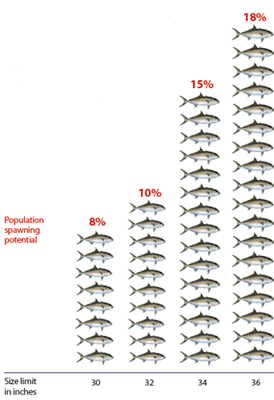Greater Amberjack: Size Matters
Raising the minimum allowable size from 30 inches to 34 would increase the number of mature females left in the water, boost the population, and potentially allow a year-round recreational fishing season.
Advantages of a 34-Inch Limit

- Overall mortality would be reduced by 21 percent even though dead discards would increase by 17 percent, if all other management measures remained the same.
- With a 21 percent mortality reduction, the June-to-July closure of recreational fishing season could be lifted, at least initially while effects are studied.
- If the recreational June-to-July closure was removed and the size limit was 34 inches, there would be no change in overall estimated mortality and only a 6 percent increase in dead discards.
- Scientists have recommended for years that the size limit should be set at a length where at least half of females are sexually mature. That's close to 35 inches.
- At the current 30-inch size limit, only about 2 percent of females are mature and capable of reproducing.
- Most amberjack caught and kept are about 31 or 32 inches—a size at which less than 10 percent are mature.
- Increasing the catch-size limit to at least 24 inches offers clear biological benefits and is a positive step toward rebuilding the population.
- At 34 inches, the spawning potential ratio is estimated to increase to approximately 15 percent without other significant changes to the fishery.
- A 34-inch amberjack is 1 year older and 5 to 6 pounds heavier than one at 30 inches.
Reasons to Act Now
- Greater amberjack have been overfished since at least 1998. The situation has been documented during the past three stock assessments, in 2000, 2006, and 2011.
- Overfishing has been occurring since at least the 2006 assessment.
- Management measures implemented in 2008 were intended to curtail overfishing but haven't worked.
- Maintaining the status quo—even if catch is down slightly from recent years—won't rebuild amberjack.
- The Gulf of Mexico Fishery Management Council's goal for a rebuilt population is a 30 percent spawning potential ratio. Now, it is estimated at less than 10 percent.
Benefits of Rebuilding
 Greater size limits would allow a larger percentage of the fish population to grow and reach the minimum healthy spawning potential goal. At the current fishing rate, this is how much of the greater amberjack population would be capable of spawning during the 10-year rebuilding plan.
Greater size limits would allow a larger percentage of the fish population to grow and reach the minimum healthy spawning potential goal. At the current fishing rate, this is how much of the greater amberjack population would be capable of spawning during the 10-year rebuilding plan.
What Happens at Various Sizes
Increasing the catch-size limit from 30 inches to 32 would benefit the amberjack fishery. With a June-July closed season, landings would drop 22 percent and total removals by 10 percent. Boosting the limit to 36 inches would provide an even more dramatic difference. Removals would drop 15 percent even if year-round fishing were allowed and by 31 percent if the June-July moratorium remained in effect.
How to Help
Visit www.PewEnvironment.org/GulfFish to learn more and join our e-alert network. Contact Sharon McBreen at [email protected] or 407-256-2812 to sign up for fish news or join our cause. For information, contact project leader Holly Binns at [email protected] or 850-727-8241.
To view the full fact sheet, including citations and additional graphics, please download the PDF above.







